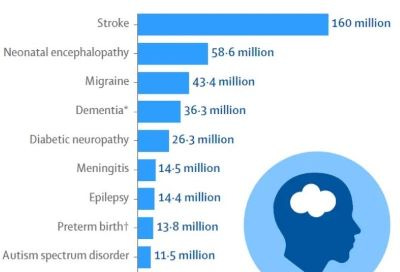Neurological conditions are the leading cause of illness and disability worldwide
Over 1 in 3 people are affected
Two recent articles in major national newspapers in the last six months discussed the prevention of two of the most common neurological diseases - stroke and dementia.
“Most Strokes Are Preventable” – Washington Post, October 23, 2023
“What Middle-Aged People Can Do Now to Help Prevent Dementia Later” - Wall Street Journal, April 8, 2024
Stroke and dementia are number one and number four, respectively, in terms of causing death, illness, and disability across the globe. They belong to the family of neurological diseases.
In the United States, every 40 seconds, someone has a stroke. and every 3 minutes and 14 seconds, someone dies of a stroke. Stroke is a leading cause of serious long-term disability.
About 80% of strokes are preventable. There are known risk factors for developing a stroke and addressing them can lower your chances of developing one.
In the United States, in 2014, there were about 7 million adults older than 65 years with dementia. This number is projected to be about 14 million by 2060.
Dementia is not inevitable. Many older adults live their entire lives without developing it. There are known risk factors for developing dementia and addressing them can lower your chances of developing it.
By looking at both the mortality (deaths) and morbidity (being unhealthy) from diseases like stroke and dementia, we can better understand the health of a population. The sum of mortality and morbidity is referred to as the "burden of disease". This can be quantified by calculating years of healthy life lost due to illness, disability, and premature death using a statistic known as disability-adjusted life years (DALYs).
A recent study revealed that neurological diseases affect 43% of the world's population (3.4 billion people), causing 443 million years of healthy life lost (or DALYs), in 2021. Neurodevelopmental and pediatric conditions accounted for about 18% of this total. Neurological illnesses have now surpassed cardiovascular diseases as the leading cause of disease burden globally.
The ten neurological conditions that accounted for the greatest DALYs in 2021 were
The number of DALYs attributable to neurological diseases rose by 18%, from 375 million years of healthy life lost in 1990 to 443 million years lost in 2021. Global population growth and aging are mostly to blame for this rise. This can be seen when age is taken into account when comparing the number of deaths and DALYs in 1990 and 2021. If the age distribution of the populations of these two time periods had been the same, the number of deaths and DALYs from neurological disorders would have decreased by about one-third. So, the increase was due to the presence of more older people.
The giant public health burden of these largely preventable causes of health loss emphasizes the need to make neurological health a global public health priority. The word prevent, or a form of it, is mentioned fifteen times in the study report. Many of these disorders have known prevention strategies including modification of risk factors over a person’s lifetime.
Risk factors for stroke are the most comprehensively studied, and in 2021, 84% of stroke DALYs worldwide were potentially preventable through the reduction of exposure to 18 identified risk factors. As highlighted before, these factors include high systolic blood pressure, smoking, high cholesterol, and elevated glucose levels.
Like most issues in public health, there are interconnections between these neurological disorders and risk factors, environment, behavior, social determinants, and now climate change. Many neurological disorders are preventable, and much progress is currently being made but more needs to be done in terms of deployment and research. The Intersectoral Global Action Plan on Epilepsy and Other Neurological Disorders 2022–2031 by the World Health Assembly, provides a blueprint for the prevention, early identification, diagnosis, treatment, and rehabilitation of disorders that affect the nervous system. Some highlights of this action plan for preventing neurological disorders are summarized below.
Promoting brain health and preventing neurological illnesses requires reducing modifiable risk factors, especially throughout brain development. This begins with preconception, pregnancy, childhood, and adolescence to promote healthy behavior, appropriate nutrition, infectious illness control, head and spinal trauma prevention, and violence and environmental pollution reduction.
There are significant connections between various neurological disorders, including dementia and stroke, and non-communicable diseases like hypertension, diabetes, and obesity. These disorders are also linked to behavioral risk factors such as lack of physical activity, unhealthy diets, tobacco use, and excessive alcohol consumption.
Smoking increases the risk of stroke and dementia. Alcohol abuse can lead to cerebellar degeneration, neuropathy, myopathy, and delirium tremens, Traffic accidents, violence, falls, and brain and spinal cord injuries are also affected by it.
Many neurological problems are preventable through immunization programs and infectious disease control. Infectious diseases like meningitis, encephalitis, neurocysticercosis, malaria, HIV, toxoplasmosis, polio, enterovirus, syphilis, and rabies contribute to global morbidity and mortality.
There were 27 million new traumatic brain injuries and close to 1 million new spinal cord injuries worldwide in 2016. The modifiable risk factors of speeding, alcohol or drug use, helmet, seat belt and child restraint use, pedestrian visibility, driver distraction or exhaustion, and traffic rule enforcement can alter the number of road traffic injuries.
Climate change is a significant global issue that has a direct impact on human health and neurological conditions. Vector-borne viruses that affect the nervous system like Zika, Japanese encephalitis, and West Nile disease are already moving from their usual habitats into new areas of the world due to temperature changes.
For the global burden, or years of healthy life lost, due to neurological disorders, an ounce of prevention is worth a pound of cure.







